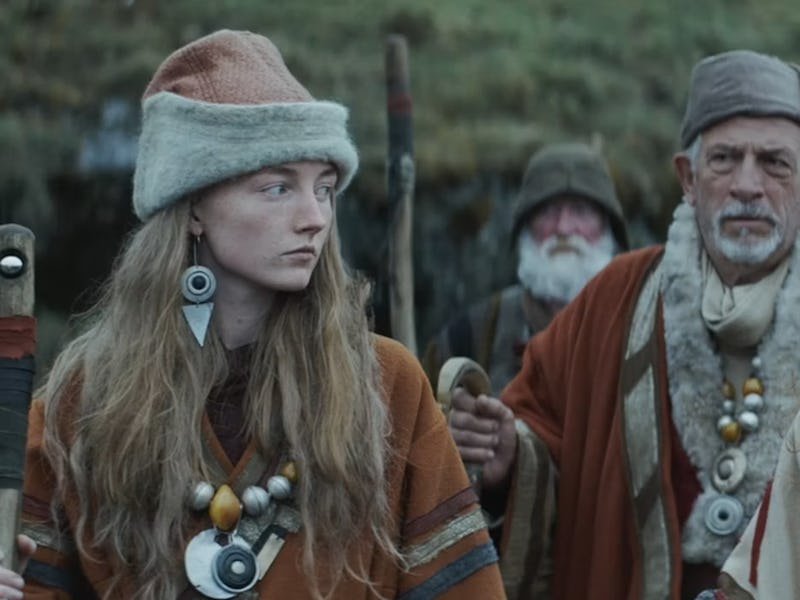Andor Episode 6 redefines a powerful message at the heart of Star Wars
Though they may not look like it, the Dhani form a saddening parallel with the real world.

Star Wars has never been afraid of touching on real-life controversy. George Lucas famously said the original movies were about the conflict between the Viet Cong and America (guess which side represents the Empire). And at the end of Revenge of the Sith, Darth Vader basically quotes President George Bush. Andor is no different, but the latest Star Wars show is taking on an equally heated topic.
In Episode 6, we see Cassian Andor and a bunch of grassroots revolutionaries pull off a heist against the Empire, but the most interesting story is happening in the background: a story of colonizers uprooting Indigenous culture.
Andor and “The Eye”
The Dhani react to The Eye.
Andor and his ragtag group of rebels didn’t pick the date of their heist at random. The Indigenous people of the planet Aldhani, the Dhani, were making their pilgrimage for the annual ritual they call the Eye on that day, which lines up with a majestic celestial event. This also made it the perfect cover for a covert operation.
Early in the episode, we watch the Empire discuss how they plan to subtly displace the Dhani from their holy site in a strategic valley — not through force, but by more nefarious means.
“It's a 10-day trek up from the Lowlands,” the commander of this Empire outpost explains. “We offered them a transport because we know they'll refuse, but then, along the way, we've placed a series of ‘Comfort Units,’ shelters and taverns with cheap local beverages.”
This reduced the number of pilgrims arriving for the Eye from 500 to 60. Before the Empire arrived, the ritual would have drawn 15,000.
The Dhani and the Empire
Erasing the culture of Indigenous peoples is an incredibly common tactic by colonizers, especially in North America.
“The systemic way that the Empire brought down numbers of people going to see The Eye was interesting,” Navajo Star Wars fan Aubree O. tells Inverse.
Aubree, who requested anonymity for privacy reasons, sees a clear parallel to the Indigenous experience. “That is exactly how a lot of customs and parts of Native culture like language have died in order to assimilate people into colonized culture,” she says.
Another key element is the fact that alcohol is presumedly used to distract the Dhani.
“Anthropologically our bodies never really had to process alcohol unless in certain ceremonies, so it was a challenge and biologically really hard on our bodies once colonization occurred,” Aubree says.
Cassian is, himself, Indigenous, so the inclusion of a Native population is fitting.
Ali Nahdee, an Anishinaabe Star Wars fan, has a much more pessimistic view of the episode. Indigenous people are often allegorized with stories about Ewoks, Jawas, and Tusken Raiders. But they haven’t always been the most respectful stories. The closest to humanization we got was in The Book of Boba Fett, where Boba (played by an Indigenous man himself) was basically adopted by a Tusken tribe, only for them to be massacred later.
“I expect no less from the Empire,” she tells Inverse. “I'm surprised they didn't straight up kill them but I'm not complaining. I enjoy not being traumatized.”
“I enjoy not being traumatized.”
Aubree also notes how the appearance of Aldhani’s Indigenous people adds an interesting element to the representation. “It definitely seemed to be a take on Nordic cultures and their Indigeneity to Europe,” she says. “I think a lot of times people only think of Indigenous as meaning the POC savage trope, but it's important to highlight that Indigenous people are everywhere.”
Though it may not be obvious, this wasn’t the only representation of Indigenous characters in Andor Episode 6. Cassian Andor himself is probably one of the last remaining of his tribe from Kenari. Andor is an Indigenous story in and of itself, and with this story of the Dhani, it’s a portrait of just how invasive and effective colonialism can be.
Andor is now streaming on Disney+.
This article was originally published on